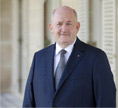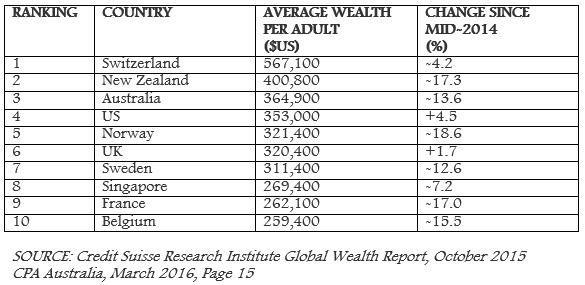
Australia
Australia is a country, and continent, surrounded by the Indian and Pacific oceans. Its major cities – Sydney, Brisbane, Melbourne, Perth, Adelaide – are coastal, but its capital, Canberra, is inland and nicknamed the "Bush Capital."
The country is known for its Sydney Opera House, Great Barrier Reef, the vast Outback (interior desert wilderness) and unique animal species including Koalas, kangaroos and duck-billed platypuses.
AS of 1 January 2016, the population of Australia was estimated to be 23 783 500 people. Due to external migration, the population increased by 141 787.
The sex ratio of the total population was 0.994 (994 males per 1 000 females) which is lower than global sex ratio. The global sex ratio in the world was approximately 1 016 males to 1 000 females as of 2015.
 Prime Minister
Prime Minister
Malcolm Turnbull
 Governor-general: Peter Cosgrove Queen: Elizabeth II
Governor-general: Peter Cosgrove Queen: Elizabeth II
MELBOURNE named world's most liveable city, for fifth year running
Melbourne has topped The Economist's livability rankings for a fifth consecutive year. But planning experts have warned that, while the livability rankings were "marketing nirvana", they were meaningless for much of Melbourne, and got in the way of improving the city.
And a social services group said the ranking failed to recognise the growing disparity between those rich enough to live where good jobs and services were, and those in areas of high unemployment, poor transport and entrenched disadvantage.
Australian cities were found to be "a relative picture of stability", while 20 per cent of the cities surveyed by The Economist magazine's Intelligence Unit experienced declines in livability over the past year.
Melbourne was ranked the world's most livable city, Adelaide fifth, Sydney seventh, Perth eighth and Brisbane 18th. None of these cities saw their ranks change in this year's report.
The most livable cities in the world were Melbourne, Vienna, Vancouver, Toronto, Adelaide and Calgary.
Melbourne has topped The Economist's livability rankings for a fifth consecutive year. But planning experts have warned that, while the livability rankings were "marketing nirvana", they were meaningless for much of Melbourne, and got in the way of improving the city.
And a social services group said the ranking failed to recognise the growing disparity between those rich enough to live where good jobs and services were, and those in areas of high unemployment, poor transport and entrenched disadvantage.
Australian cities were found to be "a relative picture of stability", while 20 per cent of the cities surveyed by The Economist magazine's Intelligence Unit experienced declines in livability over the past year.
Melbourne was ranked the world's most livable city, Adelaide fifth, Sydney seventh, Perth eighth and Brisbane 18th. None of these cities saw their ranks change in this year's report.
The most livable cities in the world were Melbourne, Vienna, Vancouver, Toronto, Adelaide and Calgary.


Australian Lifestyle
Australia has it all!
Many countries and cities are aesthetically appealing, but the reality of living there and breathing in the daily air can sour positive first impressions.
Australia is one of the few countries which can successfully satisfy both criteria. Yes, it is visually spectacular! But its residents also enjoy a high quality of life, a superb education and health system, a stable economic and political environment, clean and safe surroundings, freedom of cultural and religious expression, and technologically advanced infrastructure and transport systems.
This is objectively confirmed in the World Competitiveness Handbook 2002 and by the Economist Intelligence Unit in London which recently evaluated 130 cities worldwide, in terms of their "liveability".
Five of Australia's state capitals appeared in the top 10, with Melbourne occupying first position.
SOURCE: MIA (Migration Institute of Australia), As at 28 February 2016
AUSTRALIAN WEALTH
AUSTRALIA still has the largest spread of people who can be called middle class, according to a study from Credit Suisse Research Institute. Its latest annual Global Wealth Report says Australia leads the world with 66 per cent of adults in the middle class.
Belgium and Singapore have 60 per cent, while Italy, Japan, Taiwan and the US are at 55 per cent and New Zealand’s figure also tops 50 per cent. Average wealth is highest in Switzerland.
Top 10 countries measured by average wealth in 2015 ($US)

SYDNEY, capital of New South Wales and one of Australia's largest cities, is best known for its harbour front Opera House, with a distinctive sail-like design.
Massive Darling Harbour and Circular Quay are hubs of waterside life, with the towering, arched Harbour Bridge and esteemed Royal Botanic Gardens nearby.
Sydney Tower’s 268m glass viewing platform, the Skywalk, offers 360-degree views of the city, harbour and suburbs.
COST OF LIVING
Cost of living varies depending on the location, accommodation type and lifestyle you choose. Below is a guide for a single student. These are basic living costs and do not include tuition fees, study related costs such as textbooks and stationary, OSHC or any luxuries.




 Useful Links
Useful Links